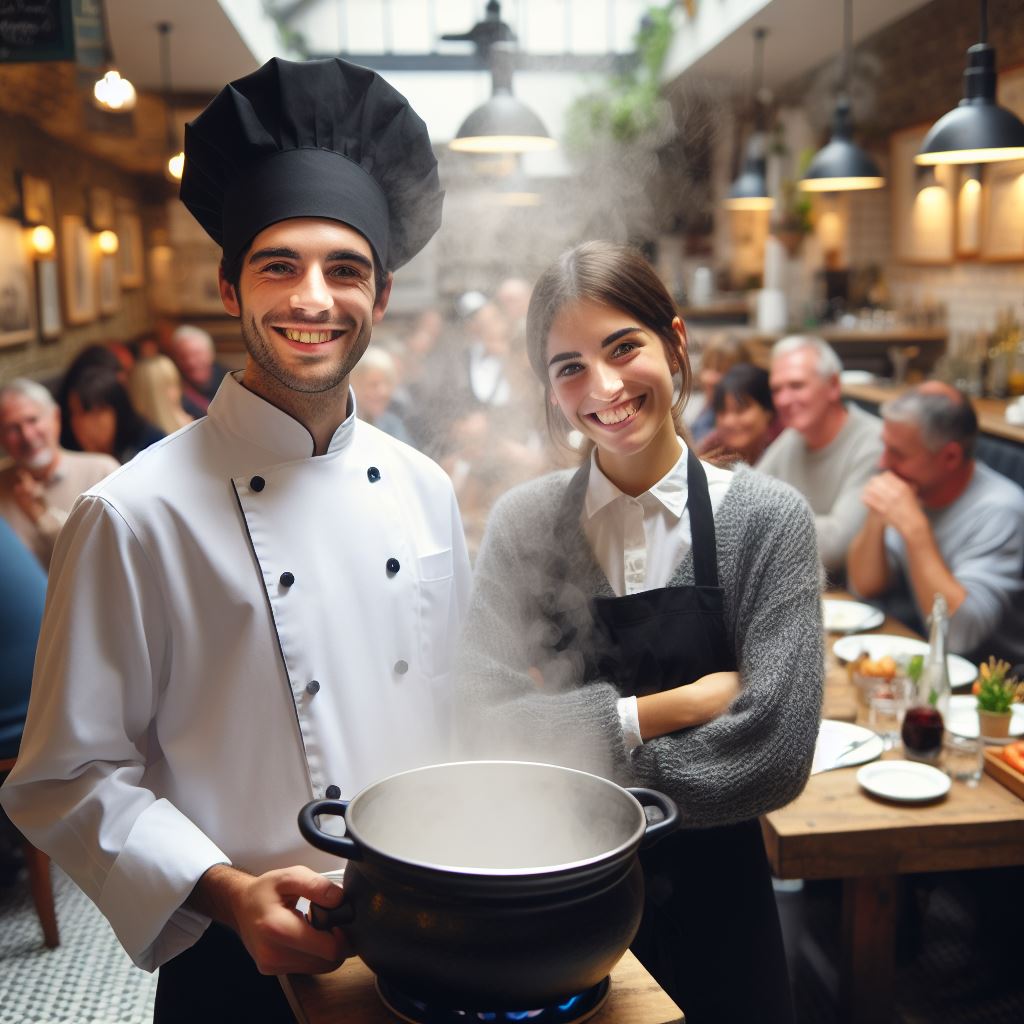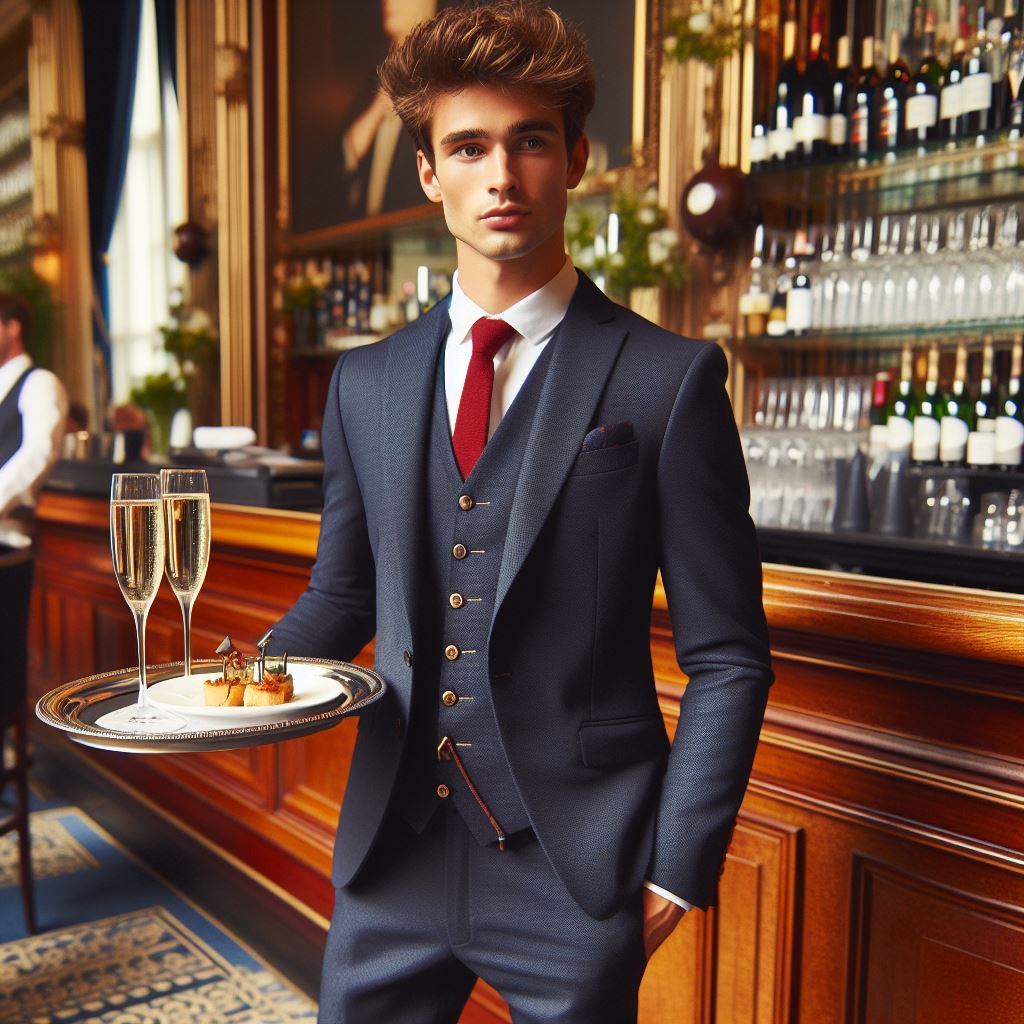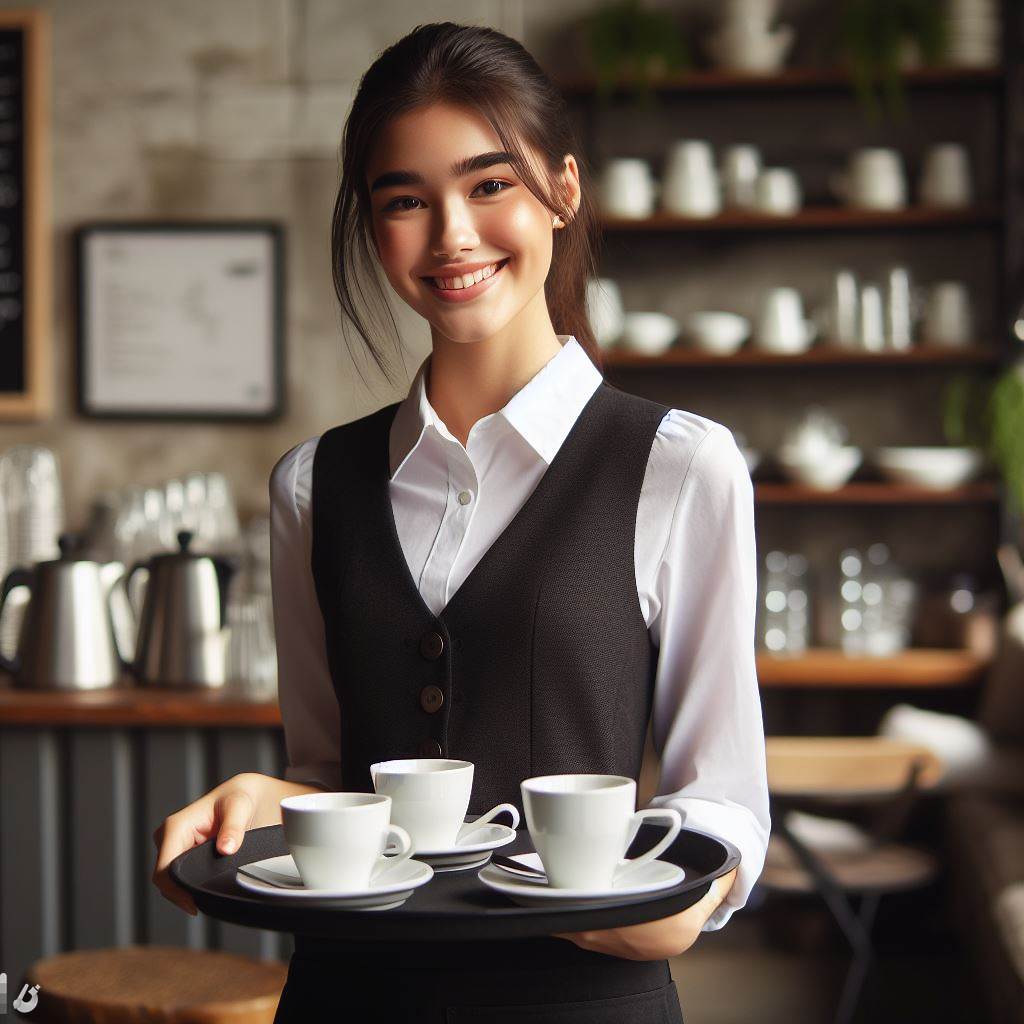Introduction
In the fast-paced world of the UK restaurant industry, the dynamic between waitstaff and chefs is crucial.
Understanding this dynamic is essential for creating a successful and efficient dining experience.
It is important to recognize the significance of the relationship between waitstaff and chefs in the context of the UK restaurant industry.
These two groups of professionals are the backbone of any successful dining establishment.
Waitstaff are responsible for delivering a high level of customer service, taking orders, and ensuring that guests have an enjoyable experience.
On the other hand, chefs work tirelessly in the kitchen, crafting culinary masterpieces that delight the taste buds of diners.
The interaction between waitstaff and chefs is vital for the smooth running of a restaurant.
Clear and effective communication is the key to avoiding mistakes and ensuring that orders are prepared correctly and delivered promptly.
Furthermore, waitstaff must have a deep understanding of the dishes being served in order to provide accurate information to customers.
They must be knowledgeable about the ingredients, cooking methods, and potential allergens to confidently answer any questions.
In addition, waitstaff often act as a liaison between the customer and the chef, relaying special requests or dietary restrictions.
This requires a level of trust and teamwork between the two parties to ensure that each individual’s needs are met.
Overall, the waitstaff and chefs in UK restaurants share a symbiotic relationship that is vital to the success of the establishment.
By understanding and appreciating the dynamic between these two crucial roles, restaurants can create a seamless and enjoyable dining experience for their customers.
Overview of the Roles and Responsibilities of Waitstaff
The waitstaff in UK restaurants is an essential part of the dining experience, responsible for ensuring customers have a pleasant and enjoyable dining experience.
Their primary responsibilities include:
Providing Excellent Customer Service
Waitstaff play a vital role in creating a positive impression on customers by delivering exceptional customer service.
They must be friendly, welcoming, and attentive to guests’ needs.
Effective Communication Skills
Clear and effective communication is crucial in the role of waitstaff.
They must understand customer requests, relay them accurately to the kitchen, and communicate specials and menu changes effectively.
Taking Orders
One of the main tasks of waitstaff is taking customers’ orders.
They must accurately record the order, ensuring all specific requests and dietary restrictions are accounted for.
Serving Food and Beverages
Waitstaff are responsible for delivering customers’ orders promptly and efficiently.
They must ensure the correct food and beverages are served to the appropriate tables and handle any issues or concerns promptly.
Providing Recommendations
Waitstaff should have a thorough knowledge of the menu and be able to provide recommendations to customers, helping them make informed choices based on their preferences and dietary needs.
In addition to these primary responsibilities, waitstaff also have additional duties that contribute to the smooth operation of the restaurant:
Table Set-Up
Before the restaurant opens, waitstaff ensure that tables are clean, properly set, and organized.
This includes setting out silverware, glasses, and napkins.
Personalized UK Career Consulting
Receive tailored career guidance designed just for you. Get actionable steps and expert support to boost your career in 1-3 days. Take control of your career now.
Get StartedBill Handling
Waitstaff are responsible for presenting bills to customers accurately and in a timely manner.
They may also process payments, including cash handling and credit card transactions.
Cleaning Duties
Waitstaff assist with maintaining cleanliness and hygiene throughout the restaurant.
This includes clearing and resetting tables, tidying up the dining area, and ensuring restrooms are clean and well-stocked.
Waitstaff are an integral part of the UK restaurant dynamic, ensuring that customers receive excellent service, have an enjoyable dining experience, and feel valued.
Their responsibilities extend beyond simply serving food and beverages, encompassing customer satisfaction, effective communication, and maintaining a pleasant atmosphere.
Read: UK Waitstaff: Balancing Speed and Hospitality
Overview of the Roles and Responsibilities of Chefs
In the dynamic world of UK restaurants, chefs play a crucial role in ensuring culinary excellence and customer satisfaction.
Their responsibilities go beyond just cooking; they encompass menu planning, food preparation, and maintaining quality control.
Let’s take a closer look at the key responsibilities and importance of chefs in the UK restaurant industry.
Key Responsibilities of Chefs in UK Restaurants
- Creating and preparing delectable dishes that meet the high standards and expectations of the restaurant.
- Ensuring that all food is cooked to perfection, maintaining consistency in taste, texture, and presentation.
- Maintaining a safe and hygienic work environment, complying with food safety regulations.
- Managing inventory and working closely with suppliers to ensure the availability of fresh and high-quality ingredients.
- Collaborating with the waitstaff to meet customer preferences and dietary requirements.
Importance of Culinary Expertise, Creativity, and Attention to Detail
Culinary expertise is a fundamental requirement for chefs in UK restaurants.
They must possess a deep understanding of different cuisines, cooking techniques, and flavor profiles.
This expertise allows them to create innovative and exciting dishes that intrigue and satisfy customers.
Chefs also need to have a creative flair to continually develop new recipes and experiment with flavors.
Their imaginative approach distinguishes restaurants and keeps customers coming back for more.
Additionally, attention to detail is essential to ensure that every plate exiting the kitchen meets the highest standards of visual appeal and taste.
Involvement in Menu Planning, Food Preparation, and Quality Control
Menu planning is a collaborative process in which chefs have a vital role.
They propose new dishes, assess ingredient availability, and consider pricing and profitability.
By leveraging their culinary expertise and market trends, chefs curate menus that excite customers while aligning with the restaurant’s vision and objectives.
Food preparation is another critical responsibility of chefs.
They diligently follow recipes, accurately measure ingredients, and ensure proper cooking techniques are applied.
Chefs also supervise the kitchen staff to maintain consistency and quality throughout the food preparation process.
Quality control is a continuous task for chefs.
They taste and evaluate every dish to ensure it meets the desired flavor profile and presentation standards.
Additionally, chefs oversee portion control, ensuring that customers receive consistent serving sizes.
Hierarchy within the Kitchen: Sous Chefs and Line Cooks
Within the kitchen, a hierarchical structure exists to ensure efficient operations.
At the top of this hierarchy is the head chef, responsible for overall kitchen management.
Assisting the head chef are sous chefs, who supervise specific sections of the kitchen and manage the line cooks.
Sous chefs, often aspiring head chefs, play a crucial role in maintaining kitchen organization, training staff, and coordinating food preparation.
Line cooks, on the other hand, execute specific tasks such as grilling, sautéing, or pastry making.
In short, chefs in the UK restaurant industry have extensive roles and responsibilities that go beyond just cooking.
Their culinary expertise, creativity, and attention to detail are crucial in delivering exceptional dining experiences.
By actively participating in menu planning, food preparation, and quality control, chefs play an integral part in the success of UK restaurants.
Read: Waiter’s Guide: Handling Difficult Customers in the UK
Your Dream Job Starts with a Perfect CV
Get a tailored CV and cover letter that captures your unique strengths and stands out in your industry. Let us help you make an unforgettable first impression.
Get StartedInteractions between Waitstaff and Chefs
In the dynamic world of UK restaurants, the interactions between the waitstaff and chefs play a crucial role in ensuring smooth operations.
The seamless collaboration between these two teams is vital for the success of any establishment.
Let’s delve into the various aspects that make these interactions so significant.
Relaying Customers’ Orders Accurately
- Waitstaff act as the vital bridge between customers and the kitchen.
- The process of relaying customers’ orders accurately is of utmost importance.
- Effective communication skills are essential for waitstaff to accurately convey the customers’ requirements.
- Through clear communication, they ensure that the kitchen staff understands the orders correctly.
- Miscommunication can lead to incorrect preparation, impacting customer satisfaction and overall experience.
Need for Effective Communication
- Smooth service and timely delivery of food rely heavily on effective communication.
- Waitstaff must be able to clearly communicate customer preferences and any special requests to the chefs.
- Chefs rely on this information to prepare the dishes according to the customers’ desires.
- Waitstaff and chefs must maintain open lines of communication throughout the service to address any issues promptly.
- Effective communication ensures a well-coordinated and enjoyable dining experience for customers.
Special Dietary Requests and Allergies
- Addressing special dietary requests and allergies is a challenging, yet essential, aspect of restaurant operations.
- Waitstaff need to be well-informed about various dietary restrictions and potential allergens.
- When customers have specific requests, waitstaff must relay the information accurately to the chefs.
- Chefs then need to carefully prepare the dishes, ensuring they are free from the specified allergens.
- Proper coordination and diligent communication are vital to prevent any cross-contamination or mistakes.
Coordination for Smooth Service
- Waitstaff and chefs must work in harmony to ensure smooth service throughout a meal.
- Timing is crucial, and communication plays a key role in coordinating the delivery of each course.
- Waitstaff must be aware of the progress in the kitchen to serve each dish at the right time.
- Chefs rely on timely updates from waitstaff to ensure proper pacing and avoid any delays.
- This coordination is vital to provide an exceptional dining experience for customers.
In fact, the interactions and collaborations between waitstaff and chefs are essential pillars in the UK restaurant dynamic.
Clear communication and accurate relay of customers’ orders are vital to ensure smooth service and timely delivery of food.
Addressing special dietary requests and allergies requires proper coordination and communication between both teams.
Their seamless collaboration creates a well-oiled machine that guarantees a remarkable dining experience for customers.
Read: Career Growth for Waitstaff in the UK Hospitality

Challenges and Tensions in the Waitstaff-Chef Dynamic
Potential challenges and tensions that may arise between waitstaff and chefs.
- Language barriers and miscommunication can lead to misunderstandings and conflicts between waitstaff and chefs.
- Different work schedules and shifts may cause difficulties in coordinating tasks and responsibilities.
- The waitstaff’s reliance on the kitchen for timely food preparation can create tension if orders are delayed.
- Different skill sets and expertise can create a hierarchical divide and potential power struggles.
- Pressure to deliver exceptional service may clash with the chefs’ focus on food quality and presentation.
Differences in priorities, work pace, and time management.
- Waitstaff prioritize customer satisfaction and providing a seamless dining experience.
- Chefs prioritize food preparation, ensuring dishes are cooked to perfection and served promptly.
- Waitstaff work at a fast pace, juggling multiple tables and attending to immediate customer needs.
- Chefs work at a different pace, meticulously preparing dishes and focusing on food presentation.
- Time management challenges arise when waitstaff need orders quickly while chefs require sufficient time for cooking.
Potential conflicts arising from customer complaints, order mistakes, or kitchen delays.
- Customer complaints about food quality or service may create tension between waitstaff and chefs.
- Mistakes in taking and relaying orders can lead to the wrong dish being prepared by chefs.
- Kitchen delays may cause waitstaff to apologize to customers and potentially receive negative feedback.
- Chefs may get frustrated with waitstaff for not accurately relaying customer requests or customization details.
- Conflicts may arise if waitstaff prioritize customer demands over following kitchen protocols.
The importance of teamwork and communication in overcoming these challenges.
- Effective communication channels and regular meetings enable waitstaff and chefs to address concerns and resolve conflicts.
- Collaborative problem-solving ensures a smooth workflow and prevents issues from escalating.
- Sharing feedback and constructive criticism allows for continual improvement and better understanding between both parties.
- Cross-training initiatives can help waitstaff understand kitchen operations and chefs appreciate front-of-house responsibilities.
- An atmosphere of mutual respect and appreciation promotes teamwork and strengthens the waitstaff-chef dynamic.
In essence, the waitstaff-chef dynamic in UK restaurants is not without challenges and tensions.
These can arise from differences in priorities, work pace, and time management.
Conflicts may also stem from customer complaints, order mistakes, or kitchen delays.
However, by prioritizing teamwork and effective communication, these challenges can be overcome, leading to a harmonious and successful restaurant operation.
Read: UK Etiquette: A Waitstaff’s Perspective
Benefits of a Positive Waitstaff-Chef Relationship
Advantages of Fostering a Positive Relationship
Building and maintaining a positive waitstaff-chef relationship has numerous advantages.
It is crucial for the success of any restaurant and contributes to a better customer service experience.
When waitstaff and chefs foster a positive relationship, it leads to improved communication and understanding.
Waitstaff can effectively communicate customer preferences and dietary restrictions to chefs, ensuring orders are prepared accurately.
Chefs, on the other hand, can share timely information about any menu changes or special dishes with the waitstaff.
Better Customer Service and Dining Experience
This enhanced communication creates a seamless coordination between the front and back of the house.
As a result, waitstaff can provide customers with accurate recommendations, describing each dish’s ingredients, flavors, and cooking methods.
Customers appreciate this level of detail and are more satisfied with their dining experience.
Benefits of Efficient Communication, Mutual Respect, and Collaboration
Efficient communication also helps in resolving any issues that may arise during service.
Waitstaff can quickly convey customers’ special requests or address any concerns to the chef.
Chefs, being aware of customers’ preferences, can cater to their needs promptly, ensuring a satisfactory dining experience.
Impact on Staff Morale and Job Satisfaction
Mutual respect and collaboration between waitstaff and chefs are crucial elements of a positive relationship.
When both parties respect each other’s role and expertise, it creates a supportive work environment.
Chefs appreciate the waitstaff’s effort in describing their dishes accurately, while waitstaff value the chefs’ culinary skills.
Collaboration between waitstaff and chefs also leads to innovation and creativity.
Chefs can experiment with new ingredients and cooking techniques based on the waitstaff’s feedback from customer interactions.
This collaboration can result in the creation of unique and exciting dishes that attract customers.
A positive waitstaff-chef relationship significantly impacts staff morale and job satisfaction.
When employees have a good relationship with their colleagues, it creates a harmonious workplace.
This positive environment fosters teamwork and encourages employees to support and help one another, resulting in higher productivity and job satisfaction.
Furthermore, a positive relationship between waitstaff and chefs also contributes to increased job satisfaction.
When employees feel valued and respected, they are more motivated to perform well.
This leads to higher job satisfaction levels, reducing turnover rates and creating a stable and reliable team.
In general, it is evident that fostering a positive waitstaff-chef relationship is essential to enhance customer service, create a harmonious workplace, and boost job satisfaction.
Efficient communication, mutual respect, and collaboration between waitstaff and chefs lead to improved service, better dining experiences, and a more satisfied team.
Optimize Your LinkedIn for Success
Boost your LinkedIn profile with a professional bio, keyword-rich headline, and strategic recommendations that attract recruiters. Stand out from the crowd and get noticed.
Optimize NowConclusion
It is crucial to understand and appreciate the dynamic between waitstaff and chefs in UK restaurants.
We have discussed the challenges faced by both roles, such as miscommunication and conflicting priorities.
However, the success of a dining experience relies on the collaboration and synergy between these two roles.
The waitstaff ensures excellent customer service and smooth operations, while the chefs deliver delectable dishes.
By recognizing the valuable contributions of both roles, we can create a harmonious and successful dining experience.
Ultimately, the waitstaff and chefs play a vital role in shaping the overall ambiance and satisfaction of restaurant guests.
Therefore, it is important for customers to acknowledge and appreciate the efforts of both roles in creating memorable dining experiences.
Next time you dine out, take a moment to appreciate the unique contributions of waitstaff and chefs, and enjoy a truly exceptional dining experience.
[E-Book for Sale]
500 Cutting-Edge Tech Startup Ideas for 2024 & 2025: Innovate, Create, Dominate
$19.99 • 500 Tech Startup Ideas • 62 pages
You will get inspired with 500 innovative tech startup ideas for 2024 and 2025, complete with concise descriptions to help you kickstart your entrepreneurial journey in AI, Blockchain, IoT, Fintech, and AR/VR.




